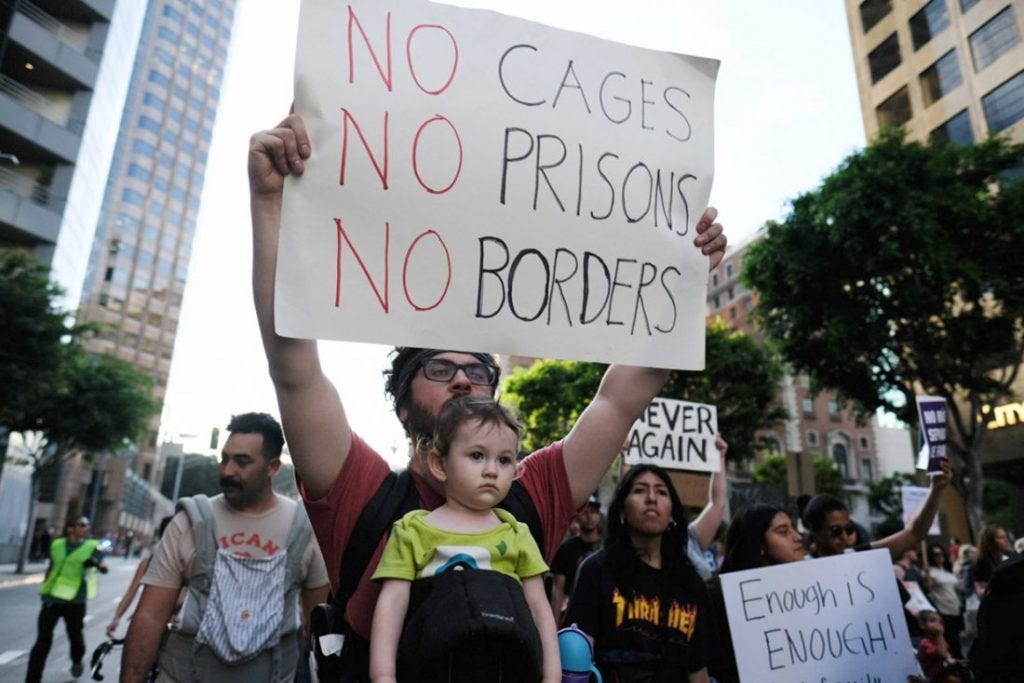The borders of Gender
"LGBTIQ is like a spider’s web which, if one is not entangled in it, can be torn with a wave of a hand; however, if one does get entangled in it, one will never escape it alive." Utikejt
Gender ideology is in every part of our society. We can’t escape it. Everyone knows someone who was ensnared and utterly destroyed by its vile grip. To combat against this many on the Right have tried to make sense of this ideology. The recent victory of Trump made some dream that now we have seen the beginning of gender ideology’s end, but I don’t think this is the case. Gender ideology is more dangerous and more subtle then it is often credited for. It’s not just some scatterbrained idea by a few kooky academics. It has a strong theoretical framework.
If we want to permanently extinguish it then an attempt to answer it must be made. This essay chiefly examines how the Left problematizes and undermines borders. To understand this attack is important, but it stems from a wider problem: the crisis of borders. This crisis is at the heart of the wrongness with the world and demands a response. The following essays in this series will give an angle to approach this crisis.
The problem of the border
Breaking the glass ceiling
LGBTIQ ideology specializes in preying on the ambiguity of borders. In fact, the destruction of borders is its essence. This is what LGBTIQ stands for first and foremost. The rejection that borders have a positive function. Borders are, in the view of the New Left, evil personified, and their abolition is the goal of any action they take. DEI and anti-racism are two of the more obvious instances of this ideology, but by looking around, it is not hard to see this issue in sayings like, “be hecking yourself” or “pushing boundaries”. It is strongly represented in the socially accepted idea that any norm has to be questioned if not broken. Transgressions against borders are seen as just and necessary.
In response to this, the Right has the tendency to try to strongly reaffirm existing borders. The attempt to ban gender and return to biological sex is one of them. But the general call for border control you hear from nationalists from all around the world comes from the same impulse. The same is also true for the Christian Right’s attempt to reaffirm marriage. However, these attempts are reactionary in the most derogatory sense. The New Left exploits a real problem that exists with borders. You don’t defeat them by unthinkingly trying to reaffirm the old borders. This approach fails to take into account what borders are, and so, remains blind.
A featherless biped
Before we can start to comprehend the problem of the border. The question of, “what is a border?” becomes necessary to answer. A provisional definition might sound: “A border is the thing that separates two entities from each other.”1 Two clear examples that give strength to this definition are walls and definitions themselves. A wall separates two plots of land from each other. Without the wall it would be difficult and often impossible to determine where the one plot of land ends and a second one begins. With this, one characteristic of borders comes clearly into view: borders create order in space.
Definitions limit the reach of a concept. They try to tell what something is and so inversely determine what it is not. Definitions find their purest form in the name. Giving something a name affirms that it is a unity and separates it from all else. In this a second characteristic of borders reveals itself: borders determine what something is.2 The two examples, together with the definition gives us a better understanding of what a border is, but this raise up two interesting questions: “who draws the border?” and “where do you draw the border?” These two questions and the problems that they imply are used by the New Left to declare borders as unjust, an evil that must be abolished.
Kierkegard in the Pyrenees
Every border has to be drawn by someone or at the very least recognized by someone as a border. This fact is something that the Right often tends to forget. There is a strong tendency to see existing borders as a given and thus as something eternal. It abstracts the border away from the conditions that made it necessary to draw it in the first place. For example, if the population of a city expands and settles beyond the wall. The existence of the wall comes into question. A new wall has to be built or the expansion has to be cut off from the city. The establishment of a border depends on a decision. This might make it seem that borders are arbitrary and in a way they are, but not every place is equally suitable for a border. To give an example from our own world, it makes sense that France has its border with Spain in the Pyrenees. To push the border beyond, would make it require far more resources to maintain. Allowing Spain possessions beyond the mountains would give them a possible foothold for the conquest of France and is thus intolerable. And so, it is “natural” for the border to settle there. However, France still has to maintain that border because if she doesn’t: She is open for conquest.
Excursion: Brussels, a city of friendship
Before we go further it is important to take a moment and consider the aspect of “decision”. Every border has to be decided. It is therefore only natural that people following an ideology that sees all borders as inherently problematic and evil are very hesitant to allow new borders to be established. This unwillingness to lay down borders is an existential threat. It is a crisis of the political. To paraphrase the German jurist Carl Schmitt, ‘the essence of the political is in the distinction between friend and enemy.’3 The deconstruction of borders paralyzes us and makes us unwilling to identify enemies. This is the ultimate crisis of borders. In a real sense, the distinction between friend and enemy is both the most fundamental border there is and at the same time it is the most concrete.
Fundamental, because it clears away all ambiguities. Friends get protected and enemies get shot. There is no middle ground to hide behind. It is concrete, because you feel it existentially. If the enemy appears in front of your eyes, you have to fight him off or he kills you. It forcefully reorients your world. War now appears to us as an essential way to establish and reestablish borders. By doing this, every war brings about a spacial reorientation.
War has become something inherently evil and to start a war is a crime in the eyes of the world. Borders are frozen in time and to change them now is forbidden. This builds pressures within countries and yet, it does not allow them to reposition when conditions that made those borders appear change. At the same time, enforcing external borders has become immoral. This is at the center of the crisis the European Union is facing. It established free movement between her member states (a good thing), but she refuses to establish a real outer border. With the migrant crisis as a result. A closely related problem, is the reckless expansion of the EU. In doing so, showing no consideration for borders and what they imply. Not every country fits within Europe, but to say this one needs to define what Europe is and what it means to be European. To lay a border is to also to determine who is in and who is out.
A two-pronged attack
Triggerlypuff [redacted] in minecraft
The New Left jumps at this double arbitrariness. It first problematizes the who, this lays the foundations of both standpoint-epistemology and intersectionality. When a feminist is screeching, “destroy the patriarchy.” She means that she wants to destroy the world where it is “men” making the decision of where the borders should be and replace it with a cabal of neurotic women. This side of the attack rest on a question of pure power. He who rules, decides and it is easily solved by ruthless suppression. We make the decision, not you. This is the approach that much of the Right wants to take and it seems that the second Trump administration is taking. This is, however, not enough and leave you open for the second attack.
A wall build of bridges
The second attack is more subtle and is centered on the problem of “exclusion”. It has two aspects: The already mentioned difficulty of determining where to draw the border and modernity’s demand for absolute borders. Three examples will make this clearer.
A stroll beyond the Po
A first example, is the question of language. When does one language end and another begin? When a renaissance Milanese man is travelling South, every new village and town he passes speaks somewhat differently from him, but he still can understand them well enough. Every mile further South, understanding becomes bit by bit more difficult and at some point beyond the Po river, talking with the locals becomes impossible. You could argue that at this point we are dealing with a different language and it may be appropriate to draw a border there. However, people who live somwhere in between Milan and this hypothetical endpoint can understand both well enough. They would say it is absurd that you draw the border there. Another example is the problem of deciding when a historical period ends. Thousands of PhD’s are written on this scenario, each one viciously attacking the other’s placement of the end. And usually they all make a good case as for why one endpoint is not sufficient and another might be better. A last example is the problem of conclusively defining an object. Trying to define what a chair is, is hard. For every definition you give there will be an exception that puts your beautiful definition into question.4 These examples show that it’s often not clear where to draw the border. There is an element of arbitrariness involved and you will almost always cut something out that someone could make a strong case to include. The problem is that you have to draw the border somewhere. Otherwise we can’t function. Drawing borders, even bad borders is a question of life and death.
These examples show that, to put a border around something always has certain arbitrariness about it. The question, “why couldn’t they be drawn differently?” can be asked. This question leads to the problem of “exclusion”. The New Left uses this problem to attack any kind of border. Modernity is especially vulnerable to this problem because it demands definitions that are crystal clear. No ambiguity is allowed. It threatens the calculability of the world. The problem of trying to define man or women purely biologically illustrates this point well.
What is a woman? (non retard edition)
Definition: a man has small reproductive cells and a woman has large reproductive cells. The strength of this definition is that with a simple operation you are able to determin who is a man and who is a woman. “Case closed” you might say. The Queer theorist, however, would confront you with the observation that the concepts man and woman contain much more than purely this biological description. It includes both a whole set of different roles that men and women take up in society and behavioral patterns they live.
For some of these roles you could argue that they are derivable from biology5, but not for all of them. Gender enters the picture to solve this problem. A concept of gender becomes even more important when you deal with the empirical fact that men and women have (somewhat) different roles depending on the society they exist in. At the same time this also sets the concept of gender under pressure. Especially if one holds universalist notions. The feminist asks, “If women can own property in society Y, then why not in society X?” Later this question turns into “If men can do Z. Why can’t women also do Z?”. Who has which gender roles doesn’t seem so obvious as one might assume and feminists jumped at this ambiguity to try to force a change in their distribution.
I identify as an attack helicopter
The coming of intersectionality in the late 80s and queer theory in the early 90s replaced the previous feminist framework.6 They came to the observation that if the notion of gender roles is interchangeable, then gender itself should be interchangeable (The troon is the weapon of choice to force this point) and if that is the case, then why are there only two genders? They were able to strengthen this idea by drawing up on the experiences of men and women who didn’t feel that they fitted into the two “prescribed” genders. They saw this as confirmation that the empirical reality of being a human being didn’t fit with “heteronormative thinking” and thus as further confirmation to abolish the classic view of gender.7 The attempt to create a ridged definition of man and woman gave the New Left the opportunity to blow up the distinction between the two. They see the distincion as unjust in three ways. First, it was drawn by men. Second, the place where the border is placed is arbitrary. Third, it leaves out experiences that should be included. It is important to add that this is not the only border that they are attempting to blow up. Everything is subject to “queering” and so, everything is at risk.
PARKINGSPACE CRIPLES ONLY!!!!
The scope of the problem is much grander than just the dissolution of gender. The crisis of borders runs through every aspect of the modern world. The traditional conservative response to this is to give ground to the Left on almost every issue and only pick a few issues that it performatively defends. The problem with this approach is obvious. You give them room to entrench their ideology and let it contaminate everything. When I said that everything can be “queered”, I meant it. The annoying woman who does annoying deaf “speech” gestures in the corner of the TV and wheelchair ramps build in front of every public entrance are but two examples of many that show Queer theories pervasive influence. All these examples exploit the problem of the “exception”. The few targets that conservatives try to defend like traditional gender roles, marriage and national borders are only defended reactively. It always ends up being nothing more then trying to reach back to the past without answering the pressent.
Conclusion
The Left is able to exploit borders because it rightfully perceives that those borders leave things out. Not everything is accounted for. The traditional response to these attacks is to reaffirm existing borders as eternal and unmovable. This defense does not solve the problem. Those exceptions are still there and in the case of the LGBTIQ the experiences of people that don’t fit “traditional” gender norms are used to erase the distinction between man and woman. With this in mind it is vital to understand borders better and to gain a concept of borders that can deal with the problem of the “exception”.
This definition is incomplete and requires a critical appraisal to fully develop as to clear out any misconceptions. This will be done in a later essay, but for the purposes of this essay it is enough.
The connection between the center and the border will be explored at a later date.
The friend-enemy distinction Carl Schmitt. Schmitt is a center piece in trying to make sens of borders.
The chair game:
A chair has 4 legs and a a surface to sit on.
What about a chair with three legs?
A chair has 3 or 4 legs and a surface to sit on.
What about a wobbling chair?
A chair is something whose purpose it is to sit on.
Is a tree stump in the forest, where people sit on, a chair?
Ad infinitum
The possibilities that technology brings puts any biological defence under serious pressure. Here the relation between Queer theory and transhumanism becomes especially clear.
Compared to the rest of the world, the Croatian Right is a decade a head on understanding gender ideology and LGBTIQ. Especially the work of
(@utikejt on twitter) has been extremely valuable. This article states her main thesis.I can’t stress how essential this is to the project of the New Left. The question of identity and personal experience is central to everything they do. Any of these experiences is seen as valid. Not just any experience that is, but all that could be. Thus society is obligated to help them be expressed.






